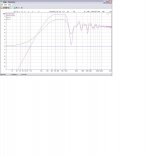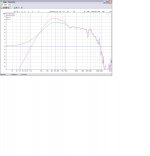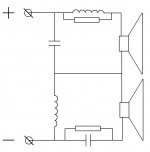The U-Frame approach will anyhow move the radiation pattern
towards a cardioid shape. There is no cancellation driver
needed. The effect comes from baffle plane being folded
towards the rear side.
If cardioid radiation pattern is the goal with OB like structures
it will be difficult to beat a U-Frame in compactness and efficiency.
Of course it is limited from its upper usable frequency because of
lambda/4 resonances according to the depth of the U-Frame.
Combining "Cancellation" approach with U-Frame will
introduce resonant behavior into the midrange and destroy
the last chance for that approach in having any advantage.
They are also consequent in offset mounting the driver on the
baffle, which gives consideraby less ripple from bass to midrange
when the position is optimized.
TOTALLY agree. all of the above makes very good sense. offsetting the driver horizonatlly AND vertically will improve matters alot. golden ratio is great for this. like in a TL i would offset vertically by about a 3rd to a 5th of the baffle height, and maybe offset horizontally by a 5th of the baffle width. this is just me riffing here, no calculations etc, but general rules of thumb only.
what you lose in bass, youll gain in ripple reduction in the passband
Anyone considering building an OB speaker needs to read and fully understand this page:
Electro-acoustic models
Just about everything we've discussed, apart from specific rearwave concellation, is covered.
I've done some more reading at Linkwitz's site, and I endorse my own earlier suggestion that the back wave can be effectively canceled by using a pipe similar to that used in the Pluto design. As long as practical, closed end, stuffed. Why bother wasting energy to cancel the back wave "actively" when you can cancel it passively?
You can get away with this for a 3 inch driver because its Vas is so small that the tube volume can easily exceed 10 times the driver Vas without making the tube too long. If you use a large radius bend, the tube can form the stand.
My only concern is the large magnet structure on some small drivers, which may reflect sound back through the cone at high frequencies and cause a restriction in a 10 cm pipe. 3 options:
- Use neo magnet drivers
- Use a larger diameter pipe
- Use a spherical enclosure
- Use a teardrop shape enclosure, B&W Nautilus style.
Electro-acoustic models
Just about everything we've discussed, apart from specific rearwave concellation, is covered.
I've done some more reading at Linkwitz's site, and I endorse my own earlier suggestion that the back wave can be effectively canceled by using a pipe similar to that used in the Pluto design. As long as practical, closed end, stuffed. Why bother wasting energy to cancel the back wave "actively" when you can cancel it passively?
You can get away with this for a 3 inch driver because its Vas is so small that the tube volume can easily exceed 10 times the driver Vas without making the tube too long. If you use a large radius bend, the tube can form the stand.
My only concern is the large magnet structure on some small drivers, which may reflect sound back through the cone at high frequencies and cause a restriction in a 10 cm pipe. 3 options:
- Use neo magnet drivers
- Use a larger diameter pipe
- Use a spherical enclosure
- Use a teardrop shape enclosure, B&W Nautilus style.
I used "Edge" to substitute a 30mm (!) driver by a 300mm driver on
a baffle about 65cm X 40cm.
I switched between
"open baffle" (pink curve) and
"closed box" (green curve).
Goal was to produce large differences in baffle diffraction
effects. The closed box condition is not the same
as the "active cancellation" approach, but it may show
the potential benefit.
A potential benefit in less pronouced ripple (epecially notches)
is only there with very small drivers operating up to
the Khz region.
The mounting of the "canceller" would have to be very close,
and it must be driven into the Khz region too to take effect.
I agree, that passive "rear wave cancellation" seems much
more attractive.
a baffle about 65cm X 40cm.
I switched between
"open baffle" (pink curve) and
"closed box" (green curve).
Goal was to produce large differences in baffle diffraction
effects. The closed box condition is not the same
as the "active cancellation" approach, but it may show
the potential benefit.
A potential benefit in less pronouced ripple (epecially notches)
is only there with very small drivers operating up to
the Khz region.
The mounting of the "canceller" would have to be very close,
and it must be driven into the Khz region too to take effect.
I agree, that passive "rear wave cancellation" seems much
more attractive.
Attachments
Oh Chris, why are you doing so to the Visatons! :0
This happened some time ago.
Luckily, the crude pattern hasn't affected the sound.
The one that got cooked happened when I had friends over. They said turn it up, (I thought it would be Ok, crossed over). The smoke came out of one (luckily, the older one), so I turned it down quick.
I'm making some phase plugs for the ones with no dustcap.
Chris
That would be fairly dependant on SPL. If you decide to use them near-field, that won't be a problem.
Like I said, give them a try. Just watch for the excursion when they're on OB. They'll be fine in a small room, but filling a large room would be difficult for a 3" driver.
Like I said, give them a try. Just watch for the excursion when they're on OB. They'll be fine in a small room, but filling a large room would be difficult for a 3" driver.
I'm excited with that design!
Think that with it the restriction on using big bass drivers for lower midrange can be overcome.
I imagine 2X12 or 15 or 18 inch drivers ... sorry... but a big things lover...
Or it could be 12 inch full range with resonance enough low and a bigger woofer in the box... - as soon as there is clarity on the design and I get onto my annual leave you will have feedback from me
Think that with it the restriction on using big bass drivers for lower midrange can be overcome.
I imagine 2X12 or 15 or 18 inch drivers ... sorry... but a big things lover...
Or it could be 12 inch full range with resonance enough low and a bigger woofer in the box... - as soon as there is clarity on the design and I get onto my annual leave you will have feedback from me
@T101, feel free to talk about this design.
I am aware that large and multiway OB can really spoil the "full range" magic so I came up with this, a relatively smaller OB.
My aim is to use two identical drivers, although some helpful and adventurous gentlemen suggested using a woofer as the cancellation driver, and it should actually work as long as it's not against physics.
I am looking forward to hearing from your test soon!
I am aware that large and multiway OB can really spoil the "full range" magic so I came up with this, a relatively smaller OB.
My aim is to use two identical drivers, although some helpful and adventurous gentlemen suggested using a woofer as the cancellation driver, and it should actually work as long as it's not against physics.
I am looking forward to hearing from your test soon!
@T101, feel free to talk about this design.
I am aware that large and multiway OB can really spoil the "full range" magic so I came up with this, a relatively smaller OB.
My aim is to use two identical drivers, although some helpful and adventurous gentlemen suggested using a woofer as the cancellation driver, and it should actually work as long as it's not against physics.
I am looking forward to hearing from your test soon!
Depends on what you call soon... a month at least, but i will prepare meanwhile
It will be something Big - I promise
If I understand right the woofer should work below the frequency at which the baffle roll off begins.
But as i see it and as the Edge sees it, there is no way to avoid baffle step compensation (RC) circuit. With smaller baffles the woofer should work to near 1 khz which I don't know whether is preferable.
Bigger baffle or U-frame on top with roll off under 200-300 hertz and less step to compensate is probably better solution...
But in our case the baffle step should not be issue, because of the cancellation. - am I right? We should use Edge only to see where the roll off begins on OB mode and watch the closed box mode with same arrangement to have an idea of what it will be like.
But if we are going to avoid baffle step compensating circuit, then we need the woofer to work higher in frequency... above the roll of point in order to fight the step... - so far I'm that far...
Last edited:
Anyone considering building an OB speaker needs to read and fully understand this page:
Electro-acoustic models
I've done some more reading at Linkwitz's site, and I endorse my own earlier suggestion that the back wave can be effectively canceled by using a pipe similar to that used in the Pluto design. As long as practical, closed end, stuffed. Why bother wasting energy to cancel the back wave "actively" when you can cancel it passively?
Agreed, OBs are the simplest of cab alignments, but have their set of caveats same as any other alignment.
Agreed, acoustic solutions for acoustic problems. Awhile back I wrote in a BWC thread that short of a humongous hyperbolic BLH, plane wave tubes (PWT) were the highest SQ alignment overall, so tapering it to a point as B&W did to create a reverse horn falls into the same category.
Note that ideally it needs to be 1/2 WL of Fs with its CSA being a function of how much acoustical damping you want with a good rule-of-thumb being 2:1 for a Qt = ~1, increasing to 3:1 at ~0.4 Qt, so like an OB or sealed, lower Fs, higher Qt drivers are required for a low corner frequency. Stuff to suit which according to MJK's software indicates ~0.4 lbs/ft^3 of polyfil is the point of diminishing returns.
GM
Hi Guys,
Can somebody give me opinion on the applied here-below idea of schematics of the filter of the speaker discussed in that thread?
If someone is able to run a simulation of it and see what happens as I don't have the needed knowledge for it
I don't insist on the compensating RL and RC circuits, but they are a way to manage different sensitivity for instance or baffle step and etc...
Best regards!
Can somebody give me opinion on the applied here-below idea of schematics of the filter of the speaker discussed in that thread?
If someone is able to run a simulation of it and see what happens as I don't have the needed knowledge for it
I don't insist on the compensating RL and RC circuits, but they are a way to manage different sensitivity for instance or baffle step and etc...
Best regards!
Attachments
- Status
- This old topic is closed. If you want to reopen this topic, contact a moderator using the "Report Post" button.
- Home
- Loudspeakers
- Full Range
- Open Baffle With a Cancelling Driver, Anyone?


